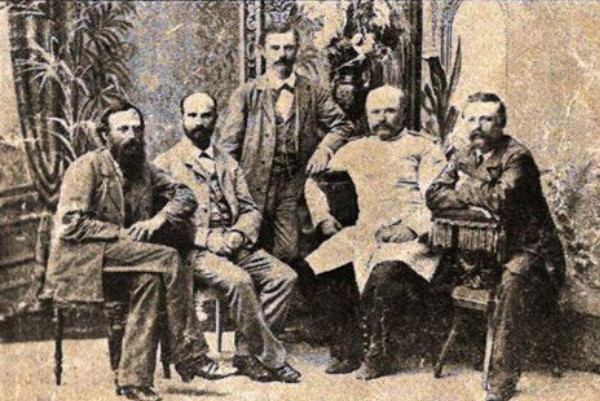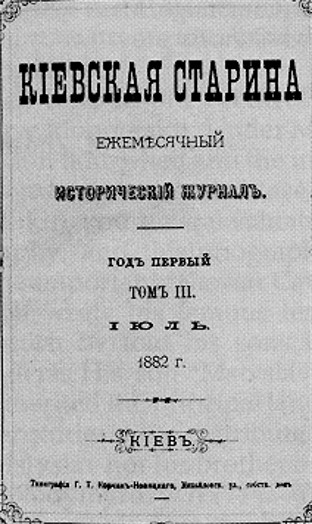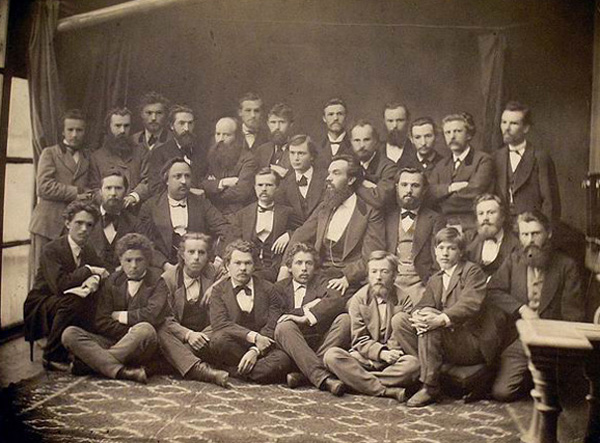Hromada of Kyiv
Hromada of Kyiv. The most active and enduring hromada in Russian-ruled Ukraine. It was not only the chief cultural, and to some extent political, society of Ukrainian intelligentsia in Kyiv but also, through its contacts with similar societies in other cities, the most important catalyst of the Ukrainian national revival of the second half of the 19th century. Although accounts vary, it was founded probably in 1859 mostly by students who felt morally obligated to improve the condition of the people through education. The first period of the hromada's history (1859–63) was devoted primarily to teaching at Sunday schools. The students who taught at the Novoe Stroenie School—O. Stoianov, Pavlo Chubynsky, V. Torsky, and the Syniehub brothers—were among the hromada's founders. A khlopoman group consisting of Volodymyr Antonovych, Tadei Rylsky, Kostiantyn Mykhalchuk, Borys Poznansky, F. Panchenko, and others joined the work of the hromada in 1859. The society did not have a clearly defined program or structure. As stated in its public declaration, ‘Otzyv iz Kieva’ (A Reply from Kyiv, published in Russkii vestnik [1862]) signed by 21 members, the hromada rejected revolutionary activity and supported education of the peasants, the development of the Ukrainian language and literature, and separatism. In 1862, at the height of its activity, the hromada's membership reached 200, and included representatives from various social strata—the peasantry, Cossacks, clergy, civil servants, burghers, and landowners—and from different nationalities—Jews and Poles as well as Ukrainians. After closing down the Sunday schools in August 1862, the authorities officially banned the hromada at the beginning of 1863. Nevertheless for a whole year it continued some of its activities, such as studying ethnography, customary law, and geography and preparing books for the masses. At the end of 1863 and the beginning of 1864 its members published a handwritten satirical magazine Pomyinytsia that contained information about the hromada's membership and activities. When the use of Ukrainian in print became severely restricted by Petr Valuev's circular, the hromada's level of activity declined.
The hromada renewed its activity in 1869. Its ranks were strengthened by the influx of new members, and included such cultural activists as Volodymyr Antonovych, Pavlo Zhytetsky, Mykhailo Drahomanov, Mykola Lysenko, Viliam Berenshtam, Mykhailo Starytsky, Fedir Vovk, Mykola Ziber, Pavlo Chubynsky, P. Kosach, V. Rubinstein, Ivan Rudchenko, Yu. Tsvitkovsky, and Oleksander Rusov. The hromada met on Saturdays at the apartments of its members. It helped young peasants to get a secondary education, and then encouraged them to work as educators in the villages. Its greatest achievement was to establish the Southwestern Branch of the Imperial Russian Geographic Society, which between 1873 and 1876 completed an astonishing amount of research in the geography, ethnography, economy, and statistics of Ukraine. Most of the hromada's members worked in the branch, among whose nearly 200 associates the most active were V. Antonovych, P. Chubynsky, and M. Drahomanov. Besides scholarly work, the hromada turned its attention to public affairs. It took over the newspaper Kievskii telegraf, which under the editorship of its members Yu. Tsvitkovsky and M. Drahomanov (1875–6) became the hromada's unofficial organ. In 1876 the secret Ems Ukase led to new repressions against the Kyiv hromada: the Southwestern Branch and the Kievskii telegraf were closed down, some hromada members (M. Drahomanov and M. Ziber) were dismissed from their leading posts at Kyiv University, and others (F. Vovk and Serhii Podolynsky) were forced to emigrate. Under the close surveillance of the authorities, the hromada reduced its activities and limited itself to strictly cultural, apolitical goals. As a result it failed to attract members from the younger generation, which began to form its own hromadas in the second half of the 1870s. To distinguish it from the new societies, the Hromada of Kyiv began to be called the Old Hromada.
In the 1880s the hromada, led by Volodymyr Antonovych, again became more active in the cultural sphere. Its energies were focused on publishing a journal, Kievskaia starina (1882–1906), devoted to Ukrainian studies. This unofficial organ of the Old Hromada was financed by Vasyl Symyrenko, Vasyl V. Tarnovsky, and Yevhen Chykalenko. At the same time the Old Hromada built a new monument on Taras Shevchenko's grave in Kaniv and republished his Kobzar (The Minstrel, 1884). To dissociate itself from M. Drahomanov's political ideas and activities in Geneva, the hromada, which 10 years before had entrusted him with the task of informing Western Europe about Ukraine and had provided the financial support for his publications, broke off relations with him in 1886.
At the end of the 19th and the beginning of the 20th centuries the Old Hromada admitted some younger members, such as Yevhen Chykalenko, Oleksander Cherniakhivsky, Ivan M. Steshenko, Serhii Yefremov, Leonid Zhebunev, Yevhen Tymchenko, and Mykola V. Levytsky, and intensified its activities. It completed the compilation of a Ukrainian dictionary that had been carried on for many years under Volodymyr Naumenko's direction, and published it under the editorship of Borys Hrinchenko in 1907–9 (photo: title page of Hrinchenko's dictionary). Thanks to the hromada's initiative the General Ukrainian Non-Party Democratic Organization was founded in 1897. Until 1917 it played an active role in organizing Prosvita societies and some Ukrainian organizations of a national scope such as the Society of Ukrainian Progressives.
BIBLIOGRAPHY
Miiakovskii, V. ‘Kyivskaia Gromada, Letopis’ revoliutsii, 1924, no. 4
Chykalenko, Ye. Spohady (1861–1907) (Lviv 1925–6; 2nd edn, New York 1955; repr. Kyiv 2003)
Riabinin-Skliarevs’kyi, O. ‘Kyïvs’ka Hromada 1870-kh rr.,’ Ukraïna, 1927, nos 1–2
Zhytets’kyi, I. ‘Kyïvs’ka Hromada za 60-tykh rokiv,’ Ukraïna, 1928, no. 1
Nazarevs’kyi, O. ‘Do istoriï Kyïvs’koï Hromady 1870-kh rokiv,’ Za sto lit, 5 (1930)
Savchenko, F. Zaborona ukraïnstva 1876 r. (Kharkiv–Kyiv 1930; repr, Munich 1970)
Lotots’kyi, O. Storinky mynuloho, 3 vols (Warsaw 1932–4)
Doroshenko, D. V. Antonovych (Prague 1942)
Arkadii Zhukovsky
[This article originally appeared in the Encyclopedia of Ukraine, vol. 2 (1989).]



